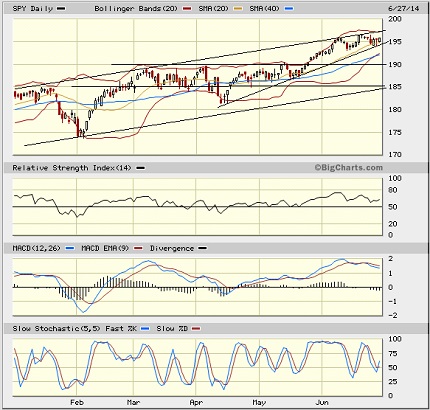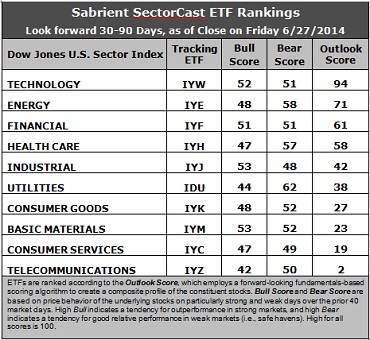Courtesy of Sabrient Systems and Gradient Analytics
 Stocks continue to hold up like troopers even though bulls have lost some traction, perhaps due to a combination of the summer doldrums and overbought technical conditions that have them biding time until the next setup for a run at new highs. To be sure, bears are AWOL and missing their opportunity to create some fear and ignite a correction. So, with little in the way of a catalyst in either direction at the moment, bulls remain in the driver seat.
Stocks continue to hold up like troopers even though bulls have lost some traction, perhaps due to a combination of the summer doldrums and overbought technical conditions that have them biding time until the next setup for a run at new highs. To be sure, bears are AWOL and missing their opportunity to create some fear and ignite a correction. So, with little in the way of a catalyst in either direction at the moment, bulls remain in the driver seat.
As we hit the mid-year mark this week, a few things are particularly notable. First almost everything is up at least a little bit, on a year-to-date basis. Gold began the year on a comeback tear, but hit a wall around mid-March and has floundered about since then. Still, after a June rally, gold is the top performing asset class year-to-date, up nearly +10%. U.S. large cap stocks (as measured by the S&P 500) are up more than +7%. Corporate bonds and NASDAQ stocks aren’t too far behind, followed by emerging markets and international developed markets. Even small caps (Russell 2000) staged a nice rally in June to get overall performance above +2%. Bringing up the rear are government bonds. But everything is positive.
The 10-year Treasury bond continues to confound many economists by holding up strong, with its yield languishing around 2.53%. Some experts are now predicting it to fall to as low as 2.2% in the second half of the year, which should continue to push income-hungry investors into dividend-paying equities.
Among the ten U.S. business sectors, income-oriented Utilities continues to display the best performance year-to-date, up about +15.5%, and REITs (which are also income-oriented) are right there with them. Energy has been quite strong recently, overtaking Healthcare for second place. Technology (which has consistently ranked at the top of our fundamentals-based sector rankings) has been coming on strong and gradually catching up with Healthcare, while Consumer Discretionary and Telecommunications (which have consistently ranked at the bottom of our rankings) are the worst performers year-to-date.
Moreover, the CBOE Market Volatility Index (VIX), a.k.a. fear gauge, continues to languish near its lows, closing Friday at 11.26. Again, some observers are predicting single digits for the VIX, while others insist that the extreme oversold conditions are ripe for reversion to the mean sometime this summer, perhaps to test resistance at 15. But short of a major black swan event, I don’t see a catalyst for such a volatility spike.
Economists are expecting strong economic growth in the second half of 2014. Many top strategists, like James Paulsen of Wells Capital, believe the greater risk lies in bonds at their current levels rather than stocks. And low interest rates coupled with zero wage inflation means that central banks (including the Federal Reserve) have no reason to scale back on market manipulation via bond buying. So, stock prices and P/E multiples still have room to run.
Therefore, I continue to suggest that investors ride the trend of rotation from speculative names into quality companies with attractive valuations, solid earnings growth projections, sound earnings quality, and preferably paying a consistent dividend. That’s not to say, however, that we won’t get a scary pullback to test the 50-day simple moving average or the 1900 level on the S&P 500, just to shake up the complacency, as Mr. Market often likes to do.
SPY chart review:
The SPDR S&P 500 Trust (SPY) closed Friday at 195.82, which is virtually the same as the prior Friday. The upper line of the long-standing bullish rising channel has been extremely tough resistance, but because it is up-sloping, stocks can continue to rise even without breaking out of the channel. Oscillators RSI, MACD, and Slow Stochastic have been loath to cycle down fully to oversold territory, but they have given up a little ground while price consolidates in place. The 20-day simple moving average offered good support all last week. Quite simply, bulls haven’t been willing to give back much while bears have been in hibernation. Nevertheless, a test of the 50-day SMA (around 192) — and preferably prior resistance at 190 — would be a healthy development and a good setup for a strong second half run. But even if bears can’t pull it back that far, there is still good potential in equities.

As I said last week, the 200 level is serving as both an enticing bullish target and a potential ambush location by hungry bears.
Latest sector rankings:
Relative sector rankings are based on our proprietary SectorCast model, which builds a composite profile of each equity ETF based on bottom-up aggregate scoring of the constituent stocks. The Outlook Score employs a forward-looking, fundamentals-based multifactor algorithm considering forward valuation, historical and projected earnings growth, the dynamics of Wall Street analysts’ consensus earnings estimates and recent revisions (up or down), quality and sustainability of reported earnings (forensic accounting), and various return ratios. It helps us predict relative performance over the next 1-3 months.
In addition, SectorCast computes a Bull Score and Bear Score for each ETF based on recent price behavior of the constituent stocks on particularly strong and weak market days. High Bull score indicates that stocks within the ETF recently have tended toward relative outperformance when the market is strong, while a high Bear score indicates that stocks within the ETF have tended to hold up relatively well (i.e., safe havens) when the market is weak.
Outlook score is forward-looking while Bull and Bear are backward-looking. As a group, these three scores can be helpful for positioning a portfolio for a given set of anticipated market conditions. Of course, each ETF holds a unique portfolio of stocks and position weights, so the sectors represented will score differently depending upon which set of ETFs is used. We use the iShares that represent the ten major U.S. business sectors: Financial (IYF), Technology (IYW), Industrial (IYJ), Healthcare (IYH), Consumer Goods (IYK), Consumer Services (IYC), Energy (IYE), Basic Materials (IYM), Telecommunications (IYZ), and Utilities (IDU). Whereas the Select Sector SPDRs only contain stocks from the S&P 500, I prefer the iShares for their larger universe and broader diversity. Fidelity also offers a group of sector ETFs with an even larger number of constituents in each.

Here are some of my observations on this week’s scores:
1. Technology remains in first place with a strong Outlook score of 94. Anything above 90 is quite impressive and dominant. Technology continues to display generally solid factor scores across the board, with a strong forward long-term growth rate, a reasonable forward P/E, the highest return ratios, and the strongest sentiment among both Wall Street analysts (upward revisions to earnings estimates), as well as good sentiment among insiders (open market buying). Energy has moved into second place on the strength of renewed optimism among sell-side analysts and the second lowest forward P/E, after Financial, which now holds third place. Healthcare and Industrial round out the top five, while Utilities has dropped from second to sixth place (which is good news for bulls).
2. Telecommunications stays in the cellar yet again with an Outlook score of 2, as it scores among the lowest in every factor in the model. It is joined in the bottom two again this week by Consumer Services/Discretionary with a score of 19, despite its strong forward long-term growth rate. Stocks within Consumer Discretionary continue to absorb earnings downgrades and a high forward P/E (even after its lagging performance this year).
3. Looking at the Bull scores, Industrial and Basic Materials share the lead with a 53, while Telecom is the laggard with a 42. The top-bottom spread has fallen to only 11 points, reflecting higher sector correlations on particularly strong market days. It is generally desirable in a healthy market to see a top-bottom spread of at least 20 points, which indicates that investors have clear preferences in the stocks they want to hold, rather than the all-boats-lifted-in-a-rising-tide mentality that dominated 2013. However, the recent lack of many particularly strong days is the likely cause of the tight range in Bull scores.
4. Looking at the Bear scores, Utilities is the leader with a 62, which means that stocks within this sector have been the preferred safe havens on weak market days (but again, there haven’t been many lately.) Industrial displays the lowest score of 48. The top-bottom spread is only 14 points, reflecting higher sector correlations on particularly weak market days (of which there have not been many). Again, it is generally desirable in a healthy market to see a top-bottom spread of at least 20 points.
5. Technology displays by far the best all-weather combination of Outlook/Bull/Bear scores, while Telecom is by far the worst. Looking at just the Bull/Bear combination, Energy and Utilities are the leaders, indicating superior relative performance (on average) in extreme market conditions (whether bullish or bearish). Telecom scores the lowest, indicating general investor avoidance of these sectors during extreme conditions. But again, there haven’t been many extreme days from which to measure in quite some time.
6. Overall, this week’s fundamentals-based Outlook rankings still look neutral, even after the fall in Utilities. Only four hold an Outlook score above 50, and three of the top six have high Bear scores and low Bull scores (Energy, Healthcare, Utilities). On the other hand, Technology, Financial, and Industrial are economically-sensitive sectors that are all in the top five.
These Outlook scores represent the view that the Technology and Energy sectors are relatively undervalued, while Consumer Services and Telecom may be relatively overvalued based on our 1-3 month forward look.
Stock and ETF Ideas:
Our Sector Rotation model, which appropriately weights Outlook, Bull, and Bear scores in accordance with the overall market’s prevailing trend (bullish, neutral, or bearish), suggests continuing to hold Technology, Industrial, and Financial (in that order) in the prevailing bullish climate. (Note: In this model, we consider the bias to be bullish from a rules-based standpoint because SPY is still above its 50-day simple moving average while also remaining above its 200-day SMA.)
Other highly-ranked ETFs from the Technology, Industrial, and Financial sectors include SPDR S&P Semiconductor ETF (XSD), First Trust Industrials/Producer Durables AlphaDEX Fund (FXR), and SPDR S&P Insurance ETF (KIE).
For an enhanced sector portfolio that enlists top-ranked stocks (instead of ETFs) from within Technology, Industrial, and Financial, some long ideas include Skyworks Solutions (SWKS), NXP Semiconductors (NXPI), Raytheon (RTN), Alaska Air Group (ALK), Fifth Third Bancorp (FITB), and SunTrust Banks (STI). All are highly ranked in the Sabrient Ratings Algorithm and also score in the top quintile (lowest accounting-related risk) of our Earnings Quality Rank (EQR), a pure accounting-based risk assessment signal based on the forensic accounting expertise of our subsidiary Gradient Analytics. We have found it quite valuable for helping to avoid performance-offsetting meltdowns in our model portfolios.
However, if you are more comfortable with a neutral bias, the model suggests holding Technology, Energy, and Financial (in that order). And if you have a bearish outlook on the market, the model suggests holding Utilities, Energy, and Healthcare (in that order).
Disclosure: Author has no positions in stocks or ETFs mentioned.
Disclaimer: This newsletter is published solely for informational purposes and is not to be construed as advice or a recommendation to specific individuals. Individuals should take into account their personal financial circumstances in acting on any rankings or stock selections provided by Sabrient. Sabrient makes no representations that the techniques used in its rankings or selections will result in or guarantee profits in trading. Trading involves risk, including possible loss of principal and other losses, and past performance is no indication of future results.



